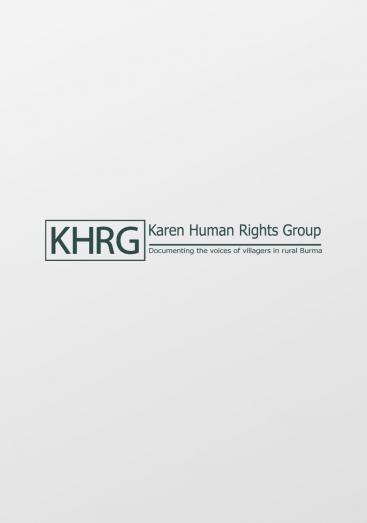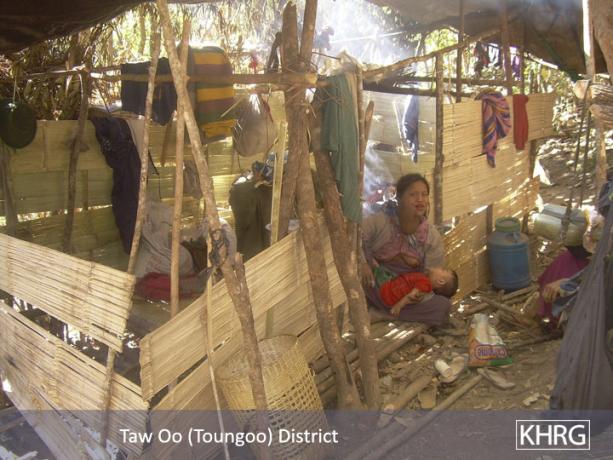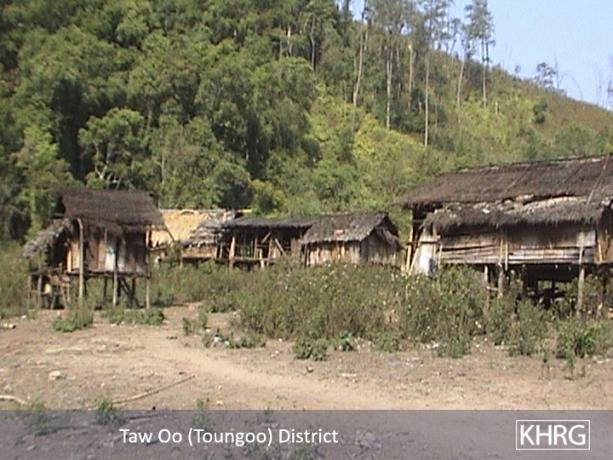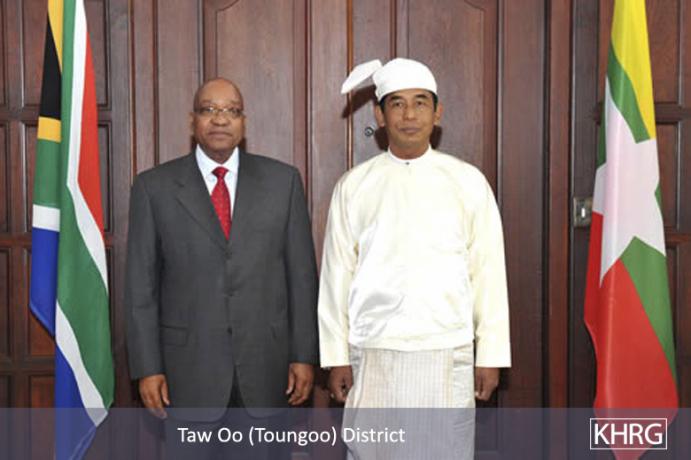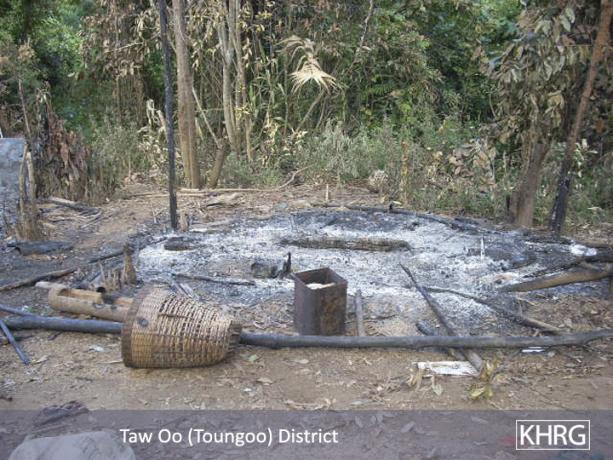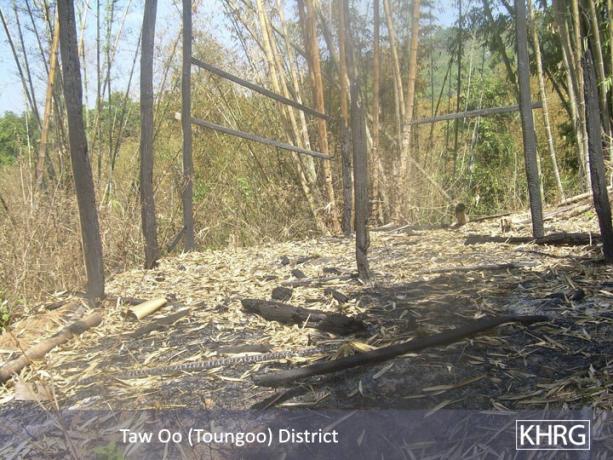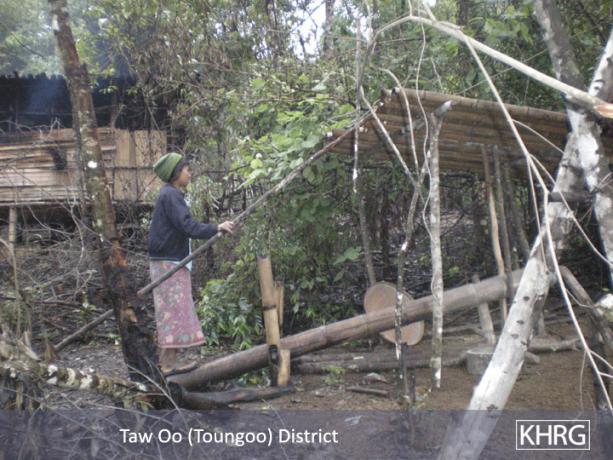This briefing document summarises research conducted by KHRG regarding the service history of Tatmadaw Brigadier General Myint Naung, and documented incidents of abuse reported to have been perpetrated by units Brigadier General Myint Naung may have commanded as Operation Commander of Tatmadaw Military Operation Command (MOC) #4. This information raises serious questions and concerns regarding the background of the current Myanmar Ambassador U Myint Naung. The South Africa government should therefore seek to obtain further information from the Myanmar government that can clarify the Ambassador's service record in the Tatmadaw, and follow up with inquiries regarding any specific incidents of serious abuse perpetrated by units under his command. Such steps are within South Africa's rights under international law governing diplomatic relations, and consistent with all states' duty under customary international humanitarian law to ensure respect for international humanitarian law erga omnes. KHRG believes that such an inquiry would contribute to raising opportunity costs for potential perpetrators of serious abuse in Burma as well as supporting domestic reforms, potentially precipitating positive changes in abusive Tatmadaw practices that could ultimately reduce the frequency with which certain abuses occur, while supporting the strategies used by local communities in Burma to claim their human rights on a day-to-day basis. This document was compiled by KHRG in response to queries by journalists and advocacy organisations in South Africa regarding the background of the Myanmar Ambassador.
I. Introduction
If the South Africa government is satisfied that it has a full understanding of the Ambassador's service record, and that the Ambassador did not command units that may have perpetrated violations of IHL, it should issue a public statement to this effect, outlining the steps it has taken to make these conclusions. If, on the other hand, the South Africa government is not satisfied that the Ambassador did not command units that may have perpetrated violations of IHL, it should continue submitting inquiries to the Government of Myanmar, or consider declaring the Ambassador persona non grata and requesting his recall by Government of Myanmar. If additional information about the service history of Ambassador Myint Naung becomes available, for example regarding different command positions at different times, primary documentation collected by KHRG may be able to identify involvement in other abuses in violation of international norms.The South Africa government should seek to clarify Ambassador Myint Naung's service history and potential responsibility for individual, documented incidents of serious violations of international humanitarian law. KHRG wishes to emphasise that this is not a call to categorically denounce all Tatmadaw officers or Myanmar government officials or disregard basic obligations to treat foreign representatives with courtesy. Rather, in light of the information outlined in Sections II and III below indicating the Ambassador's potential involvement in grave violations of IHL, the South Africa government should request from the Myanmar government comprehensive information about the ambassador's service in the Tatmadaw, including the unit number, dates and deployment locations relating to all command positions previously held by Ambassador Myint Naung. The South Africa government should then examine abuses documented in connection with those units, and further investigate or inquire into specific incidents of concern until it has a full picture of the Ambassador's service history.
KHRG believes that an inquiry by the South Africa government is reasonable given questions and concerns that arise from the information detailed in this note; it is also within South Africa's rights under international law relevant to diplomatic relations,[3] and consistent with obligations under treaty and customary IHL that members of the international community ensure respect for international humanitarian law erga omnes.[4] It is not credible to assume that domestic legal or other accountability procedures within the Government of Myanmar, or specifically the Tatmadaw, have taken any steps to determine Brig-Gen. Myint Naung's involvement in violations of IHL documented by KHRG and others.[5]
Moreover, if an inquiry justifiably results in an adverse impact on the career prospects of a former Tatmadaw officer, KHRG believes that this could help to increase the perceived opportunity costs of utilising abusive practices for currently-serving Tatmadaw officers who will be in a position to order, or permit, violations of international humanitarian and human rights law in the future. It could also encourage the perception domestically that further measures for accountability and compliance with international norms are palatable, and necessary, insofar as they can help to avoid future similar international inquiries into past conduct by Tatmadaw officers. Ultimately, if an inquiry by the South Africa government can contribute to even an incremental reduction or change in abusive conduct by currently-serving Tatmadaw officers, this offers vital assistance to communities currently facing abuse in eastern Burma.
II. Service history of Brigadier General Myint Naung
On March 14th 2011, the state-run New Light of Myanmar reported that an U Myint Naung had been appointed as the Ambassador Extraordinary and Plenipotentiary of the Republic of the Union of Myanmar to the Republic of South Africa.[6]On July 12th 2011, U Myint Naung's credentials were presented to and accepted by the President of the Republic of South Africa, Jacob Zuma.[7] Publicly-available information, including articles published by Burma's state media, academic works by experts on the Tatmadaw, and exile news agencies indicates that Ambassador U Myint Naung and Brig-Gen. Myint Naung are the same person, and that the latter likely commanded Tatmadaw units during major combat operations in Karen State.
In August 2010, The Irrawaddy newspaper reported that a Tatmadaw Brigadier General Myint Naung had been transferred to the Myanmar Ministry of Foreign Affairs.[8] Public sources indicate that Brigadier General Myint Naung likely commanded Tatmadaw Military Operation Command (MOC) #4 at least between June 2007 and February 2008. It is possible that he commanded MOC #4 prior to June 2007 and subsequent to February 2008, however KHRG could not confirm a longer period of command via public sources. Some time after February 2008, and prior to September 2008, public information suggest Brig-Gen. Myint Naung was appointed as head of the Tatmadaw's Bayinnaung combat training school, a military institution that trains Tatmadaw personnel in counter-insurgency tactics, located in Toungoo District, or Thandaunggyi Township by government designations.
Figure 1 below shows information which KHRG has gathered to date, listed in roughly chronological order. All information is from public sources unless otherwise indicated; where available, online versions of sources have been hyper-linked in related footnotes.
Figure 1: Service History
|
Date
|
Information
|
|
July 17th 2005
|
The New Light of Myanmar reports that "Colonel Myint Naung of Phugyi Station" attended a tree planting ceremony at Taikkyi Station on July 17th 2005.[9] The article does not mention a specific Tatmadaw unit in connection with Col. Myint Naung, however Phugyi, also transliterated 'Hpugyi' is the official headquarters of MOC #4,[10] and individual battalions under MOC #4 have been reported by the Network for Democracy and Development (NDD) to be headquartered in Phugyi and Taikkyi, as well as other proximate villages or towns in Yangon Region.[11]
|
|
June 7th 2007
|
An article in the New Light of Myanmar mentions "Phugyi Station Commander Brig-Gen. Myint Naung". The article does not mention a specific Tatmadaw unit, however Phugyi, also transliterated 'Hpugyi' is the headquarters of MOC #4.[12]
|
|
February 2008
|
An appendix in the book Building the Tatmadaw by Tatmadaw insider Maung Aung Myoe, cites Brig-Gen Myint Naung as Tatmadaw MOC #4 Commander, as of February 2008.[13]
|
|
September 25th 2008
|
A Burmese-language article published by the Yoma3 news agency attributes command responsibility for incidents perpetrated by battalions under MOC #4 in South Okalappa in Rangoon in September 2007 to "former MOC #4 Commander" Brig-Gen. Myint Naung. The article indicates that, by September 2008, Brig-Gen. Myint Naung is serving as the head of Bayinnaung combat training school in Thandaunggyi Township, Kayin State.[14]
|
|
August 24th 2010
|
A Burmese-language article published in the Irrawaddy indicates that Brig-Gen Myint Naung continued to serve as the head of Bayinnaung combat training school until his appointment to the ministry of foreign affairs in August 2010.[15]
|
|
October 2011
|
A non-public source informs KHRG that the wife of Tatmadaw officer Brig-Gen Myint Naung is named Swe Swe Thein. Documents dated September 14th 2011 available on the website of the South Africa Government's Department in International Relations & Cooperation also list Swe Swe Thein as the wife of the current ambassador U Myint Naung.[16]
|
Note that some public sources also name a Col. Tint Wai as a former MOC #4 Commander prior to May 2007.[17] Other public sources, meanwhile, including state media suggest that Col. Tint Wai has served as the Myanmar military attaché to China since at least June 2007, and possibly since late 2006.[18] Tatmadaw experts have also noted that it is unlikely that an officer holding the rank of Colonel would server as an MOC commander on anything other than a temporary basis without being promoted to the rank of Brigadier General, or replaced.[19] Due to conflicting sources about the identity of the MOC #4 commander prior to June 2007, however, Section III below only summarises incidents documented in connection to MOC #4 after June 2007, when the New Light of Myanmar described Brig-Gen. Myint Naung as "Phugyi Station Commander." If additional information about the service history of Ambassador Myint Naung becomes available, primary documentation collected by KHRG may be able to identify involvement in prohibited acts perpetrated at other times and related to other units.
III. Documented incidents linked to units under Tatmadaw MOC #4
The information listed in Section II of this briefing document suggests an approximate time frame for Brig-Gen. Myint Naung's tenure as MOC #4 Commander, beginning in June 2007 and lasting until at least February 2008; this period may extend beyond February 2008, depending on when he was appointed to Bayinnaung combat training school. In addition to September 2007 incidents documented by Human Rights Watch and Yoma3 related to the government crackdown on monk-led protests in Rangoon,[20] which KHRG did not document, evidence gathered by KHRG field researchers inside Burma indicates that battalions under MOC #4 committed serious human rights abuses, including grave violations of humanitarian law, during the same time period. KHRG's documentation indicates that these battalions attacked on civilian communities, destroyed villages and agriculture and killed villagers in Toungoo, Nyaunglebin, and Papun districts during the last months of a major Tatmadaw offensive, which spanned the years 2005 to 2008 and took place in northern Karen State and eastern Bago Region.
The repeated and large-scale targeting of civilians in violation of international humanitarian law (IHL) by Tatmadaw units involved in the 2005-2008 Offensive was condemned by both the UN Special Rapporteur on the situation of human rights in Myanmar and, in a rare public statement, the International Committee of the Red Cross (ICRC).[21] Covering the same period, based upon primary documentation by field researchers in the area, KHRG published 43 reports,[22] each detailing repeated grave violations of IHL by Tatmadaw units. While KHRG field researchers were not in all cases able to identify the specific units responsible for the violations, four reports highlighted abuses committed by soldiers under the command of MOC #4. Importantly, many of these reports can be triangulated by comparison to reporting by Amnesty International and a variety of local organisations active inside Burma, which all have published extensive documentation covering the period.[23]
Figure 2 below summarises documented incidents linked to MOC #4 during the period November 2007 and April 2008, when the unit may have been commanded by Myint Naung. Items are listed in roughly chronological order; all information is from KHRG primary documention and other published sources, and online versions of sources have been hyper-linked in related footnotes.
Figure 2: Incidents linked to MOC #4
|
Date
|
Information
|
|
November 2007 to April 2008
|
KHRG and The Irrawaddy report the deployment of seven battalions (LIBs #701, 702, 703, 704, 705, 706, 707, and 710) under MOC #4 to southern Toungoo District and adjacent areas of northern Nyaunglebin and Papun districts in November 2007, as reinforcements for the Tatmadaw offensive initiated in the area during 2005.[24] The Free Burma Rangers (FBR) also report the deployment of seven battalions under MOC #4 as part of the offensive, with four battalions in Papun and three in Toungoo; in May 2008 FBR reported that three battalions under Tactical Operations Command (TOC) #2 of MOC #4 operated out of several camps between southern Toungoo and northern Papun districts until April 1st 2008, when they rotated with TOC #1 of MOC #4.[25]
|
|
November 30th to December 10th 2007
|
KHRG reports that soldiers under MOC #4 carry out multiple attacks on displaced villagers and settlements in Th'Ay Kee area of Toungoo District in December 2007.[26] Documentation by KHRG includes photos and video of a civilian hiding site burned at Th'ay Kee, and details on attacks and destruction of homes in at least four hiding sites. KHRG also releases a video showing children displaced during the attack on Th'Ay Kee, which included the destruction of the school.[27] These attacks are also reported by the Free Burma Rangers (FBR).[28]
|
|
January 1st 2008
|
FBR reports that soldiers in LIB #704 under MOC #4 shoot and kill one villager and wound another in an attack on civilians in Yaw Kee village, located between Mone Township in northern Nyaunglebin District and Tantabin Township in southern Toungoo District.[29] The report notes that Yaw Kee has been attacked multiple times during previous months, including being mortared and burned down in October 2007, prior to the arrival of MOC #4 in the area.
|
|
March 4th and 5th 2008
|
KHRG reports that MOC #4 troops attack Lay Poh Der and Gheh Yuh Der villages in the Lay Kee area of Kay Bpoo village tract in northern Papun District, adjacent to southern Toungoo District.[30] The attacks include the destruction of at least nine homes and three hillside rice fields. The incident is also documented by FBR, which notes that 80 residents of Gheh Yuh Der, and approximately 400 civilians from nearby communities, fled the attacks.[31]
|
|
April 19th 2008
|
KHRG reports that two columns from LIB #706 under MOC #4 returned to Buh Kee village in Tantabin Township in southern Toungoo District which had already been attacked and burned by MOC #4 troops on December 5th 2007. Civilians in hiding in the area flee the incoming patrol, abandoning essential property including rice, salt, clothes, blankets, and cooking equipment, which is subsequently looted by MOC #4 soldiers.[32]
|
Footnotes:
[1] Note that "U" is a Burmese-language honorific, approximately equivalent to the English-language "Mr."
[2] KHRG uses the noun 'offensive' to indicate coordinated military activity by 10 or more battalions operating in concert. This usage is distinct from 'offensive' as an adjective, which contrasts military operations designed to obtain control over new territory, as opposed to 'defensive' military operations designed to hold a particular position. Distinguishing between usages of the term, particularly the former, is important so that activity during the period 2005-2008 is understood differently from the day-to-day targeting of civilians by Tatmadaw battalions, a practice which remains ongoing.
[3] Vienna Convention on Diplomatic Relations, Article 9, April 18th 1961, 23 U.S.T. 3227, 500 U.N.T.S. 95. The Convention entered into force on April 24th 1964 and, at the time of writing, 187 states are party to the treaty, including South Africa and Myanmar.
[4] International Committee of the Red Cross (ICRC) Customary International Humanitarian Law (IHL) database, Rule 144: Ensuring Respect for International Humanitarian Law Erga Omnes. According to the ICRC: 'States may not encourage violations of international humanitarian law by parties to an armed conflict. They must exert their influence, to the degree possible, to stop violations of international humanitarian law.' This obligation is also expressed in Common Article 1 of the1949 Geneva Conventions, to which 194 states are party, including South Africa and Myanmar.
[5] The absence of such procedures has been noted by the Special Rapporteur on Human Rights in Myanmar, who has repeatedly called for domestic or international investigation into widespread and systematic violations of international human rights and humanitarian law that continue to be documented nearly twenty years after his office was established; see: Progress report of the Special Rapporteur on the situation of human rights in Myanmar, Tomas Ojea Quintana, UN HRC, March 10th 2010, A/HRC/13/48, paras.120-122; Report of the Special Rapporteur on the situation of human rights in Myanmar, UN GA, September 15th 2010, A/65/368, paras.61-75, 91(c); Progress report of the Special Rapporteur on the situation of human rights in Myanmar, Tomas Ojea Quintana, UN HRC, March 7th 2011, A/HRC/16/59, paras.25-27, 97, 103; Report of the Special Rapporteur on the situation of human rights in Myanmar, UN GA, September 16th 2011, A/66/365, paras.73-80, 90. The 2008 Myanmar Constitution, in force since November 2010, meanwhile, prohibits legal or other proceedings against senior Tatmadaw officers who have held administrative posts for 'any act done in the execution of their respective duties' and structurally prevents civilian authorities from investigating, trying or otherwise holding accountable actors from within the military; see: Constitution of the Republic of the Union of Myanmar, Union of Myanmar Ministry of Information, 2008, Ars.20(b), 319, 445. The International Labour Organisation (ILO), which maintains a Liaison Officer in Yangon and has conducted an ongoing process of negotiation and investigation into violations of prohibitions on forced labour since 1997, has also noted lack of accountability for Tatmadaw perpetrators of forced labour, in contrast to civilian officials; see, for example: Developments concerning the observance by the Government of Myanmar of the Forced Labour Convention, 1930 (No.29), International Labour Office Governing Body, March 11th 2011, GB.310/5, para.8;Developments concerning the observance by the Government of Myanmar of the Forced Labour Convention, 1930 (No.29), International Labour Office Governing Body, November 3rd 2010, GB.309/6, para.11.
[6] "U Myint Naung accredited to South Africa," The New Light of Myanmar, 14 March 2011, p.2.
[7] "Myanmar Ambassador presents Credentials to South African President," The New Light of Myanmar, 29 July 2011, p.2.
[8] "More Senior Officers Reportedly Resign to Join USDP," The Irrawaddy, August 24th 2010 (Burmese language); andEnglish version.
[9] "Trees planting ceremony takes place in Taikkyi Station," The New Light of Myanmar, 21 July 2005.
[10] Maung Aung Myoe, Building the Tatmadaw: Myanmar armed forces since 1948. Singapore: Institute of Southeast Asian Studies, 2009, p.80.
[11] See: Civil and Military Administrative Echelon of State Peace and Development Council in Burma, Network for Democracy and Development (NDD), May 2007, p.99. According to the document, battalions under MOC #4 are headquartered in Hmawbi (LIBs #701, 702, 703), Phugyi (LIBs # 704, 706, 708); Yangon (LIB #705); Gyophu (LIB #707); and Taikkyi (LIBs #709 and 710). All of these locations except Yangon are located in Hmawbi and Taikkyi townships in northwest Yangon Region.
[12] "Lt-Gen Myint Swe participates in tree planting ceremonies in Yangon North District," New Light of Myanmar, 8 June 2007; Maung Aung Myo, Building the Tatmadaw, p.80.
[13] Maung Aung Myoe, Building the Tatmadaw, p.232. Respected Burma academics and researchers have noted Maung Aung Myoe's access to – and sympathy for – the Tatmadaw. The working paper from which Building the Tatmadaw was developed, for example, has been described by academic Dr. David Steinberg as 'basically an uncritical look at the military...' that '...contain[s] much useful information on command structure and organization.' See: David Steinberg, Burma: The state of Myanmar, Washington: Georgetown University Press, 2001 p.97 fn.42. Academic Maung Zarni notes that Maung Aung Myoe is 'a former lecturer at Burma's National Defence College' (see: "Why Soldiers Don't Rebel in Than Shwe's Burma," The Irrawaddy, October 4th 2010); while numerous citations in Maung Aung Myoe's published works refer to his conversations or contacts with Tatmadaw officers, commanders, and senior government officials. See, for example, Maung Aung Myoee, Neither Friend Nor Foe: Myanmar's Relations with Thailand Since 1988, Singapore: Institute of Defence and Strategic Studies Nanyang Technological Univeristy, 2002 Chapter 2 "Buffer Zone: A Source of Tension," endnotes 1, 4-6, 7, 13, 25-26, 52, 54, 78.
[14] Note that only the original Burmese language version of this article refers to Brig-Gen. Myint Naung as "former MOC #4 commander"; that information has been omitted from English translations. See: "Monk killers and monastery robbers,"Yoma3 News Agency, September 25th 2008 (Burmese language); and English Translation.
[15] The Burmese version of a 2010 Irrawaddy Article mentioning Brig-Gen. Myint Naung's transfer to the Ministry of Foreign Affairs describes him as "principal" of Bayinnaung; note that this information was omitted from the English-language version of the article. See: "More Senior Officers Reportedly Resign to Join USDP," The Irrawaddy, August 24th 2010 (Burmese language); and English version.
[16] See: "Heads of Diplomatic Mission (In Order of Precedence)," Department of International Relations and Cooperation, Republic of South Africa, 14 September 2011, p.11.
[17] Crackdown: Repression of the 2007 Popular Protests in Burma, NDD May 2007, p.99. Human Rights Watch's report on the September 2007 government crackdown subsequent to monk-led protests around the country mentions Col. Tint Wai as the OCC 4 [MOC 4] Commander in its description of incidents in South Okalappa in Rangoon, including the killing of civilians; see: Crackdown: Repression of the 2007 Popular Protests in Burma, Human Rights Watch, December 2007, p.101. Note however that the report does not cite a source for attributing command of OCC 4 to Col. Tint Wai; it may be based on the May 2007 NDD Echelon and therefore dated. Col. Tint Wai is also listed as a [former] MOC #4 Commander on the European Commission's targeted sanctions list; see: "Commission Regulation (EU) No 411/2010 of 10 May 2010 amending Council Regulation (EC) No 194/2008 renewing and strengthening the restrictive measures in respect of Burma/Myanmar," European Commission, 10 May 2010, item G45a.
[18] See for example: "Secretary-1 Lt-Gen Thein Sein arrives in Beijing," New Light of Myanmar, 11 June 2007, p.10. In November 2007, the Chinese military's media outlet PLA Daily published an interview with the Myanmar military attaché Col. Tint Wai in which the attaché mentioned coming to China "last year"; see: "An interview with the Myanmar military attaché to China," PLA Daily, November 27th 2007. Subsequent and publicly available New Light of Myanmar articles, as well the Chinese Ministry of Foreign Affairs website list Col. Tint Wai as Burma's current military attaché to China. See for example: "Myanmar delegation led by President U Thein Sein pays homage to Buddha's Tooth Relic in Beijing," New Light of Myanmar, 30 May 2011, p.1.
[19] Tatmadaw insider Maung Aung Myoe explains that "Regional Commanders are major generals and LID or MOC commanders are brigadier generals." See: Maung Aung Myoe, Building the Tatmadaw, p.81.
[20] Crackdown: Repression of the 2007 Popular Protests in Burma, Human Rights Watch, December 2007, p.101; "Monk killers and monastery robbers," Yoma3 News Agency, September 25th 2008 (Burmese language); and English Translation.
[21] "Report of the Special Rapporteur on the situation of human rights in Myanmar, Paulo Sergio Pinheiro", UN Human Rights Council (HRC), February 12th 2007, A/HRC/4/14 paras.55-6, 58; "Myanmar: ICRC denounces major and repeated violations of international humanitarian law," ICRC, June 29th 2007, News Release 82/07
[22] Of these 43 reports, 6 were Thematic Reports, 27 were Field Reports and 10 were News Bulletins. Each report details multiple, and in some cases more than one hundred, incidents of abuse.
[23] For comprehensive background on the 2005 to 2008 Tatmadaw offensive targeting civilians in northern Karen State and east Bago Region, see: Self-protection under strain: Targeting of civilians and local responses in northern Karen State, KHRG, August 2010, especially pp.15-22. For additional background on the 2005-2008 Offensive see, inter alia: Crimes Against Humanity in Eastern Myanmar, Amnesty International, June 2008; "Burma: Army Forces Thousands to Flee," Human Rights Watch, November 2006; Shoot on Sight: The ongoing SPDC offensive against villagers in northern Karen State, Burma Issues, December 2006; Campaign of Brutality, Free Burma Rangers (FBR), April 2008; State of Terror, Karen Women's Organisation, February 2007.
[24] "Militarisation, violence and exploitation in Toungoo District," KHRG, February 2008; "Burmese Army Reinforces Troops for Dry Season Military Offensives," The Irrawaddy, November 30th 2007.
[25] "Burma Army troops kill villagers and IDPs as they mass troops with over 90 battalions now in northern Karen State, Burma," FBR, January 2008; "As Thousands Suffer the Effects of Cyclone Nargis, Villagers Suffer Continued Brutality by the Burma Army in Karen State," FBR, May 2008.
[26] "SPDC troops burn villages and step up operations against civilians in southern Toungoo District," KHRG, December 2007; "Militarisation, violence and exploitation in Toungoo District," KHRG, February 2008.
[27] "Video: Displaced children in Northern Karen State," KHRG, May 2008.
[28] "Burma Army Kills Three Villagers, Hundreds Flee New Attacks," FBR, December 2007.
[29] "People struggle to survive attacks in northern Karen State as villagers are captured and killed in central Karen State, Burma," FBR, January 2008.
[30] "Burma Army attacks and civilian displacement in northern Papun District," KHRG, June 2008. KHRG researchers also documented an attack on Gheh Yuh Der in which 14 homes were burned down on August 8th 2007, before MOC #4 was deployed to the area; see: "Increased roads, army camps and attacks on rural communities in Papun District," KHRG, November 2007.
[31] "Over 2,100 displaced as Burma Army Mortars Villages and Burns Homes in New Attacks," FBR, March 2008.
[32] "Attacks, killings and the food crisis in Toungoo District," KHRG, August 2008.

